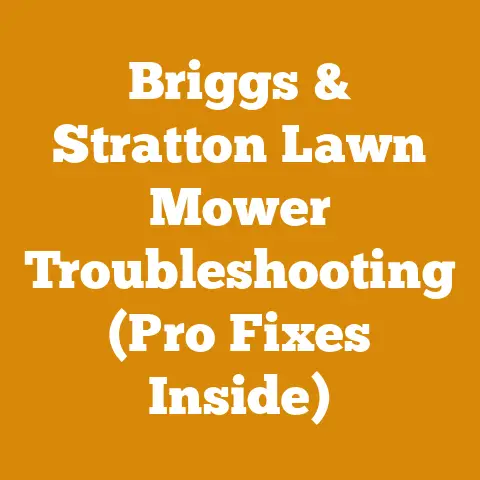Used Chainsaw Sales (5 Pro Tips for Safe Online Buys)
(Image: A split image. One side shows a brand new, gleaming chainsaw, pristine and untouched. The other side shows a rusty, heavily used chainsaw, caked in sawdust and grime, with visible signs of wear and tear.)
Diving into the Used Chainsaw Market: My Pro Tips for Safe Online Buys
The allure of a bargain. But buying a used chainsaw online can feel like navigating a minefield. I’ve been there, done that – more than once. I’ve learned some hard lessons over the years, lessons that have saved me a lot of money and, more importantly, kept me safe.
My journey with chainsaws started young, helping my grandfather clear fallen trees after storms on our family property. I quickly learned the difference between a well-maintained saw and one that’s been neglected. A faulty chainsaw isn’t just an inconvenience; it’s a serious safety hazard. These experiences have shaped my approach to buying used chainsaws, and I’m eager to share my hard-won wisdom.
This guide is designed to equip you with the knowledge you need to navigate the used chainsaw market safely and confidently. I’ll cover everything from what to look for in a listing to the questions you should ask the seller, and even how to inspect the saw once you receive it. My goal is to help you find a reliable tool without breaking the bank.
The Siren Song of Secondhand: Why Buy Used?
Before we dive into the nitty-gritty, let’s address the elephant in the room: why bother with a used chainsaw when you can buy a new one? The answer, as always, is complex, but it often boils down to economics.
- Cost Savings: This is the most obvious advantage. A used chainsaw, even a high-quality one, can often be purchased for a fraction of the price of a new model. This is particularly appealing for occasional users or those on a tight budget.
- Access to Higher-End Models: A used professional-grade chainsaw might be within your reach financially, whereas a new one would be out of the question.
- Learning and Experimentation: A less expensive, used chainsaw allows you to experiment with different models and features without a significant investment. This can be invaluable for learning about chainsaw mechanics and maintenance.
- Environmental Considerations: Buying used is a more sustainable choice, as it extends the life of an existing product and reduces the demand for new manufacturing.
However, the potential savings come with risks. You need to be diligent and informed to avoid buying a lemon. That’s where these pro tips come in.
Pro Tip #1: Decoding the Online Listing: Spotting the Red Flags
The online listing is your first point of contact with the chainsaw and the seller. It’s crucial to analyze it carefully for clues about the saw’s condition and the seller’s honesty.
Scrutinizing the Description: Words Matter
The listing description is more than just words; it’s a window into the seller’s knowledge and the saw’s history.
- Vague Language: Be wary of descriptions that are overly vague or lack specific details. Phrases like “used but in good condition” or “runs well” are red flags. A responsible seller will provide more information, such as the saw’s age, usage history, and any recent maintenance.
- Inconsistent Information: Look for inconsistencies between the description and the photos. For example, if the description claims the saw is only a year old, but the photos show significant wear and tear, something is amiss.
- Missing Information: The absence of key information can be just as telling as what’s included. If the listing doesn’t mention the saw’s model number, engine size, or bar length, it’s a sign that the seller may not know much about it or is deliberately withholding information.
- Exaggerated Claims: Be skeptical of claims that seem too good to be true. Phrases like “like new” or “barely used” should be treated with caution, especially if the price is significantly lower than comparable models.
Technical Deep Dive: Decoding Chainsaw Model Numbers
Chainsaw model numbers are more than just random digits; they often contain valuable information about the saw’s specifications. For example, a Stihl MS 271 indicates a mid-sized professional saw, while a Husqvarna 455 Rancher signifies a powerful homeowner model. Understanding these codes can help you quickly assess the saw’s capabilities. Here’s a breakdown of some common features model numbers reveal:
- Engine Displacement (cc): Higher numbers generally indicate larger, more powerful engines.
- Intended Use (Professional vs. Homeowner): Some manufacturers use specific prefixes or suffixes to denote the saw’s intended use.
- Features (e.g., anti-vibration, easy start): Some model numbers include codes that indicate specific features or technologies.
My Personal Experience: I once bought a “lightly used” chainsaw online. The description was vague, but the price was tempting. When I received the saw, it was clear that it had been heavily used and poorly maintained. The engine was caked in grime, the chain was dull, and the bar was bent. I learned my lesson the hard way: never underestimate the importance of a detailed and honest description.
The Power of Pictures: Seeing is Believing (or is it?)
Photos are a crucial part of any online listing. They provide visual evidence of the saw’s condition and can reveal details that the description omits.
- Multiple Angles: The listing should include photos from multiple angles, showing the entire saw, including the engine, bar, chain, and handle. This allows you to assess the overall condition and identify any potential problems.
- Close-Ups: Close-up photos of key areas, such as the engine, carburetor, and spark plug, can reveal important details about the saw’s maintenance history. Look for signs of wear and tear, corrosion, or damage.
- Cleanliness: A clean chainsaw is not necessarily a sign of good maintenance, but a filthy one is almost certainly a red flag. Excessive dirt, grime, or oil buildup can indicate neglect.
- Staged Photos: Be wary of photos that appear to be staged or overly edited. A seller who is trying to hide something may use tricks like lighting and filters to make the saw look better than it is.
- Missing Photos: If the listing is missing photos of certain parts of the saw, ask the seller to provide them. This could be a sign that they are trying to conceal damage or defects.
Case Study: The “Hidden Crack” Incident
I once encountered a listing for a used chainsaw that looked promising at first glance. The photos were well-lit and showed the saw from multiple angles. However, upon closer inspection, I noticed a faint line on the engine casing. I asked the seller for a close-up photo of that area, and they reluctantly revealed a hairline crack. This crack, which was not mentioned in the description, would have rendered the saw unusable.
Technical Data Point: The Impact of Cracks on Engine Performance
Cracks in the engine casing can compromise the saw’s performance and safety. Even small cracks can lead to air leaks, which can disrupt the air-fuel mixture and cause the engine to run poorly. Larger cracks can weaken the engine structure and increase the risk of catastrophic failure.
Seller Reputation: Trust, but Verify
The seller’s reputation is a crucial factor to consider when buying a used chainsaw online. A seller with a long history of positive reviews is more likely to be honest and reliable than one with a limited or negative track record.
- Feedback Score: Check the seller’s feedback score on the platform you are using. A high score indicates that the seller has a good reputation and is likely to provide a positive buying experience.
- Reviews: Read the seller’s reviews carefully. Look for comments about the accuracy of their descriptions, their responsiveness to questions, and the quality of their products.
- Communication: Pay attention to the seller’s communication style. Are they responsive to your questions? Are they willing to provide additional information or photos? A seller who is evasive or uncooperative may be trying to hide something.
Practical Tip: Using Online Reputation Tools
Several online tools can help you research a seller’s reputation. These tools aggregate reviews from multiple sources and provide insights into the seller’s overall performance.
Pro Tip #2: Asking the Right Questions: Unveiling the Truth
Don’t be afraid to ask the seller questions. A responsible seller will be happy to answer your questions honestly and thoroughly. This is your chance to clarify any doubts and gather additional information about the saw.
Key Questions to Ask:
- Age and Usage History: How old is the chainsaw? How often has it been used? What types of tasks has it been used for?
- Maintenance History: What maintenance has been performed on the chainsaw? When was the last time it was serviced? Do you have any maintenance records?
- Repairs: Has the chainsaw ever been repaired? If so, what repairs were performed? Were the repairs done by a professional?
- Problems: Are there any known problems with the chainsaw? Does it start easily? Does it run smoothly? Are there any unusual noises or vibrations?
- Reason for Selling: Why are you selling the chainsaw? Are you upgrading to a new model? Are you no longer using it?
- Bar and Chain: What is the length and type of the bar? What is the condition of the chain? How many times has the chain been sharpened?
- Availability of Manual: Do you have the owner’s manual for the chainsaw?
- Return Policy: What is your return policy? Can I return the chainsaw if I am not satisfied with it?
Technical Insight: The Importance of Maintenance Records
Maintenance records provide valuable information about the saw’s history and can help you assess its overall condition. Look for records of oil changes, spark plug replacements, air filter cleanings, and carburetor adjustments. A well-maintained chainsaw is more likely to be reliable and long-lasting.
My Story: The Power of Asking Questions
I was once interested in a used chainsaw that appeared to be in good condition. However, when I asked the seller about the maintenance history, they admitted that they had never changed the oil. This was a major red flag, as neglecting oil changes can lead to serious engine damage. I decided to pass on the saw, saving myself a potentially costly repair bill.
Interpreting the Answers: Reading Between the Lines
The seller’s answers are just as important as the questions you ask. Pay close attention to their tone, their level of detail, and any inconsistencies in their responses.
- Evasiveness: If the seller is evasive or unwilling to answer your questions directly, it’s a sign that they may be hiding something.
- Inconsistencies: Look for inconsistencies between the seller’s answers and the information provided in the listing or photos.
- Reluctance: If the seller seems reluctant to provide additional information or photos, it’s a red flag.
- Enthusiasm: A seller who is enthusiastic about the chainsaw and eager to share information is more likely to be honest and trustworthy.
Data Point: Response Time and Seller Reliability
Studies have shown a correlation between response time and seller reliability. Sellers who respond quickly and thoroughly to inquiries are generally more trustworthy than those who are slow to respond or provide vague answers.
Pro Tip #3: Negotiating the Price: Getting a Fair Deal
Negotiating the price is a crucial part of buying a used chainsaw. Don’t be afraid to haggle, but be realistic and respectful.
Researching Market Value: Knowing Your Numbers
Before you start negotiating, research the market value of the chainsaw you are interested in. This will give you a baseline for your offer and help you avoid overpaying.
- Comparable Listings: Look for similar chainsaws that are currently for sale online. Compare their prices, conditions, and features.
- Online Price Guides: Several online price guides can help you estimate the value of used chainsaws. These guides take into account factors such as age, condition, and model.
- Local Market: Check the prices of used chainsaws in your local area. This can give you a more accurate picture of the market value in your region.
Technical Tip: Factoring in Repair Costs
When researching market value, don’t forget to factor in the cost of any potential repairs. If the chainsaw needs a new chain, bar, or carburetor, you should deduct the cost of these repairs from the asking price.
Making a Reasonable Offer: The Art of the Deal
When making an offer, be reasonable and respectful. Don’t lowball the seller, but don’t be afraid to start below their asking price.
- Justify Your Offer: Explain why you are offering a particular price. Point out any flaws or issues with the chainsaw that justify a lower offer.
- Be Prepared to Walk Away: Don’t get emotionally attached to the chainsaw. Be prepared to walk away if the seller is unwilling to negotiate a fair price.
- Consider the Value: Think about the value the chainsaw will bring to you. What are you going to use it for? How long do you expect it to last?
- Be Respectful: Always be polite and respectful, even if you disagree with the seller’s price.
My Negotiation Tactic: The “Repair Estimate” Approach
I often use the “repair estimate” approach when negotiating the price of a used chainsaw. I’ll get a quote from a local repair shop for any potential repairs and use that quote to justify a lower offer. This shows the seller that I’m serious about buying the saw but also aware of its potential problems.
Payment Methods: Protecting Yourself
Choose a payment method that offers some protection in case of fraud or misrepresentation.
- PayPal: PayPal offers buyer protection, which can help you recover your money if the seller misrepresents the chainsaw or fails to deliver it.
- Credit Card: Credit cards also offer some protection against fraud. You can dispute charges if you don’t receive the chainsaw or if it’s not as described.
- Avoid Cash: Avoid paying with cash, as it’s difficult to track and offers no protection in case of fraud.
Data Point: Online Payment Fraud Statistics
According to the Federal Trade Commission, online payment fraud is on the rise. In 2022, consumers reported losing over \$5.8 billion to online fraud schemes. Choosing a secure payment method can help you protect yourself from becoming a victim.
Pro Tip #4: Inspecting the Chainsaw: Kicking the Tires (Virtually and Physically)
Once you receive the chainsaw, it’s crucial to inspect it thoroughly to ensure that it matches the description and is in good working order.
Visual Inspection: A Close Look
Start with a visual inspection of the entire chainsaw. Look for any signs of damage, wear and tear, or neglect.
- Engine: Check the engine for cracks, leaks, or corrosion.
- Bar: Inspect the bar for bends, cracks, or excessive wear.
- Chain: Examine the chain for sharpness, damage, or missing teeth.
- Handle: Check the handle for cracks, looseness, or damage.
- Safety Features: Make sure all safety features, such as the chain brake and throttle lock, are working properly.
Technical Insight: Checking Bar Rail Wear
Bar rail wear is a common problem with used chainsaws. Over time, the rails on the bar can wear down, making it difficult for the chain to stay on track. To check for bar rail wear, run your finger along the rails. If they feel uneven or have a sharp edge, the bar may need to be replaced. A quick check with a machinist’s ruler can show how much deviation there is from the original rail height.
Functional Testing: Putting it to the Test
After the visual inspection, perform a functional test of the chainsaw. This will help you identify any mechanical problems.
- Starting: Try to start the chainsaw. Does it start easily? Does it require multiple attempts?
- Idling: Once the chainsaw is running, let it idle. Does it idle smoothly? Does it stall or sputter?
- Acceleration: Rev the engine. Does it accelerate smoothly? Does it hesitate or bog down?
- Chain Brake: Engage the chain brake. Does it stop the chain immediately?
- Vibration: Pay attention to the amount of vibration. Excessive vibration can indicate engine problems.
My Experience: The “Hidden Carburetor Issue”
I once bought a used chainsaw that started easily and idled smoothly. However, when I tried to accelerate the engine, it would bog down and stall. After taking it to a repair shop, I discovered that the carburetor was clogged. This issue was not apparent during the initial inspection, but it became obvious during the functional test.
Compression Test: Assessing Engine Health
A compression test is a more advanced diagnostic procedure that can help you assess the health of the engine.
- Compression Tester: You’ll need a compression tester to perform this test.
- Procedure: Remove the spark plug and screw the compression tester into the spark plug hole. Pull the starter cord several times and record the reading on the tester.
- Interpretation: A healthy engine should have a compression reading within the manufacturer’s specifications. A low reading can indicate worn piston rings, damaged valves, or other engine problems.
Technical Data Point: Compression Requirements for Chainsaws
The minimum compression requirement for a chainsaw engine varies depending on the model. However, a general rule of thumb is that the engine should have a compression reading of at least 100 PSI. Readings below 100 PSI indicate that the engine may need to be rebuilt.
Pro Tip #5: Safety First: Chainsaw Operation and Maintenance
Buying a used chainsaw is just the first step. Operating and maintaining it safely is crucial for preventing accidents and ensuring its longevity.
Safety Gear: Protecting Yourself
Always wear appropriate safety gear when operating a chainsaw. This includes:
- Eye Protection: Safety glasses or goggles to protect your eyes from flying debris.
- Hearing Protection: Earplugs or earmuffs to protect your hearing from the loud noise of the chainsaw.
- Head Protection: A hard hat to protect your head from falling branches or debris.
- Hand Protection: Gloves to protect your hands from cuts and abrasions.
- Leg Protection: Chainsaw chaps or pants to protect your legs from accidental cuts.
- Foot Protection: Steel-toed boots to protect your feet from falling logs or chainsaw injuries.
Technical Requirement: Chainsaw Chaps Specifications
Chainsaw chaps are designed to stop the chain instantly upon contact, preventing serious injuries. They are typically made from multiple layers of ballistic nylon or Kevlar. The effectiveness of chainsaw chaps is measured by their “cut-through time,” which is the amount of time it takes for the chain to cut through the chaps. Look for chaps that meet or exceed ANSI standards.
Safe Operating Procedures: Avoiding Accidents
Follow safe operating procedures to avoid accidents.
- Read the Manual: Familiarize yourself with the chainsaw’s operating manual.
- Clear the Area: Clear the area around you of any obstacles or hazards.
- Stable Footing: Maintain a stable footing and a firm grip on the chainsaw.
- Proper Posture: Use proper posture and body mechanics to reduce strain and fatigue.
- Avoid Overreaching: Avoid overreaching or cutting above shoulder height.
- Watch for Kickback: Be aware of the risk of kickback and take steps to prevent it.
- Never Work Alone: Never work alone when operating a chainsaw.
My Close Call: The Importance of Proper Stance
I once had a close call while cutting a fallen tree. I was using an awkward stance, which caused me to lose my balance. The chainsaw kicked back, and I narrowly avoided a serious injury. This experience taught me the importance of maintaining a stable footing and a firm grip on the chainsaw.
Regular Maintenance: Keeping it Running
Perform regular maintenance to keep your chainsaw running smoothly and prevent problems.
- Chain Sharpening: Sharpen the chain regularly to maintain its cutting efficiency.
- Chain Lubrication: Keep the chain properly lubricated to reduce friction and wear.
- Air Filter Cleaning: Clean the air filter regularly to ensure proper airflow to the engine.
- Spark Plug Replacement: Replace the spark plug periodically to maintain optimal engine performance.
- Fuel Mixture: Use the correct fuel mixture to prevent engine damage.
- Storage: Store the chainsaw properly when not in use.
Technical Tip: The Impact of Dull Chains on Safety
A dull chain is not only less efficient, but it’s also more dangerous. A dull chain requires more force to cut, which increases the risk of kickback and other accidents. Sharpening the chain regularly is crucial for both safety and performance.
Data Point: Chainsaw Accident Statistics
According to the Consumer Product Safety Commission, chainsaws cause approximately 36,000 injuries each year in the United States. Many of these injuries are preventable with proper safety precautions and regular maintenance.
Conclusion: A Final Word of Advice
Buying a used chainsaw online can be a rewarding experience, but it requires careful planning, thorough research, and a healthy dose of skepticism. By following these pro tips, you can increase your chances of finding a reliable tool at a fair price and avoid the pitfalls of the used chainsaw market.
Remember, safety should always be your top priority. Invest in the necessary safety gear, follow safe operating procedures, and perform regular maintenance to keep your chainsaw running smoothly and prevent accidents.
Happy cutting! And remember, always prioritize safety when working with power tools. The best deal is never worth risking your health or well-being.






